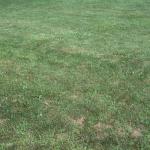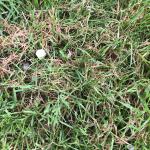Red Thread and Pink Patch
Red thread is caused by the fungus Laetisaria fuciformis. Pink patch, caused by Limonomyces roseipellis, is a different disease which closely resembles red thread. Pink patch was once considered to be a form of red thread due to similarities in symptoms, disease cycle, epidemiology, host range, and appearance. While the two diseases sometimes occur together, pink patch is uncommon in the Northeast. Both diseases occur on turf that is growing slowly because of low fertility, lack of sunlight, drought, or other sources of stress.
Signs and Symptoms
Symptoms of pink patch and red thread appear as roughly circular, pinkish red to tan patches, 2-4 inches in diameter. The red thread pathogen produces a red or dark pink stroma (a structure consisting of fungal mycelium and plant tissue) which can be seen with the naked eye on infected leaves. A mix of healthy and diseased grass blades gives the turf a ragged appearance. In dry conditions, the stroma become brittle, are easily broken and detached, and may be spread by equipment or fall into the thatch where they remain viable for up to two years. Under wet conditions, pink, cottony tufts of mycelium and conidia (spores) may be produced.
Pink patch spreads much more slowly than red thread, is less severe, and does not produce cottony tufts of mycelium. Grass blades are covered with a pink, gelatinous mycelium which can survive for long periods in plant debris.
Life Cycle
Red thread survives unfavorable periods as desiccated stroma, or in infected plant material. Reproductive structures are spread by water, wind, equipment, and people. The fungus requires a film of moisture on leaves for germination and infection. The pathogen enters grass blades through stomata or through wounds. Red thread is seen in the cooler weather of spring and fall, when the turf is still growing slowly. The fungus is capable of growth over a wide range of temperatures, but the optimum range is 60-75°F. Over 75°F, the growth rate of the fungus decreases significantly, and it ceases at 85°F. Pink patch survives as mycelium in plant debris and is also capable of growth at a wide range of temperatures.
All species of turf are susceptible to red thread, though perennial rye and fescues are the most susceptible. Red thread and pink patch are favored by cool temperatures, frequent rain or irrigation, and high humidity. Both pathogens are limited to the plant foliage and individual blades die from the tips down. Neither pathogen will kill turf crowns or roots, but severe, recurrent infections may eventually weaken turf health. Healthy turf will recover quickly when it enters a period of vigorous growth.
Cultural Management
- Maintain adequate and complete fertility (potassium, phosphorus, and calcium as well as nitrogen) as determined by soil tests.
- A light application of quick release nitrogen reduces disease severity and is generally the only treatment necessary on residential lawns.
- Maintain soil pH between 6.0 and 7.0.
- Water deeply and infrequently while preventing moisture stress.
- Avoid late afternoon, evening, and light, frequent irrigations which extend periods of leaf wetness. Remove morning dew from grass by dragging a hose over it.
- Prune trees and shrubs to improve air circulation and increase light penetration.
- Keep mower blades to sharp to minimize leaf wounding which can enhance infection.
- Collect grass clippings when the disease is active or turf is growing slowly to reduce the amount of fungal stroma that is incorporated into the thatch.
- Manage thatch, which can harbor the pathogen.
- Overseed with resistant varieties of turfgrass. Several resistant varieties of perennial ryegrass, fescues, and Kentucky bluegrass are available.
Chemical Management
Fungicides are available, but applications are seldom necessary for management of red thread and pink patch, especially in residential settings. Fungicides registered for red thread include products containing azoxystrobin, penthiopyrad, polyoxin D, and propiconazole. More information is available in the disease management section of the UMass Professional Turf IPM Guide: http://ag.umass.edu/turf/professional-turf-ipm-guide


